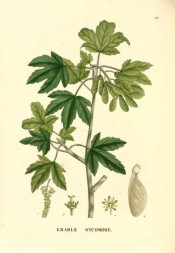Acer pseudoplatanus L.
Fully hardy, fast growing, spreading, rounded, deciduous tree with ovate, 5-lobed, dark green leaves. The pendant panicles of yellow-green flowers are followed by green or red winged fruits. To 30m. [RHSE, Hilliers’].
Horticultural & Botanical History
First botanically described by Linnaeus in 1753 as Acer pseudoplatanus, the name by which it is still known [Sp. Pl. p.1054/1753].
An ancient garden plant, quite variable in nature and in horticulture. Johnson’s Dictionary lists three varieties, purpureum, subobtusum, blunt-leaved, and variegatum. Once an important timber tree as the following extract attests, and could well have been imported by Macarthur to assess its utility at Camden.
‘Whether from an ornamental point of view or in respect of the quality and quantity of timber produced, the Sycamore must be reckoned amongst the most valuable of introduced trees. For planting on the sea-coast or in fairly exposed situations it has many advantages, while even in smoky localities it can hold its own, particularly in the suburban districts of our larger towns and cities.
The Sycamore survives to a great age, the well-rounded trunk often attaining a height of 60 or 70 feet, and 20 feet in girth, while the far-spreading branches of somewhat tufted foliage of an unusually dark shade of green, impart to the tree an easy and graceful style of growth. As a field and hedgerow tree the Sycamore is largely cultivated, it standing exposure well, affording a great amount of shelter and shade and not seriously affecting the surrounding herbage.
The uses to which Sycamore timber is put are many and varied, for though essentially a fancy wood, it is, nevertheless, one of great utility, and enters largely into the work of turnery and furniture making. In addition to its uses for fancy articles, printing-blocks J bobbins, backs for brushes, rollers for wringing and washing machines, parts of piano- fortes and other musical instruments and calendar machines are made of Sycamore. Cabinet-makers use the wood for many purposes; and when contrasted with that of a darker colour it is very effective. Even in a young state, when fresh felled, large quantities of Sycamore are supplied for the making of brush backs and for toys and small ornaments. Bread plates are usually made of Sycamore wood, as also are milk-pails and dairy utensils generally.’ [British-Grown Timber and Timber Trees p.121/1916].
The illustration used here is from the French botanist Jaume Saint-Hilaire [Saint-Hilaire Arb. pl.28/1824].
History at Camden Park
Grown in the gardens before 1843. Listed in all published catalogues [T.15/1843].
Notes
Published Feb 19, 2009 - 05:14 PM | Last updated Jun 14, 2011 - 04:45 PM
| Family | Aceraceae |
|---|---|
| Category | |
| Region of origin | Europe, Asia |
| Synonyms |
|
| Common Name | Sycamore |
| Name in the Camden Park Record | Acer pseudo-platinus – sycamore |
| Confidence level | high |
